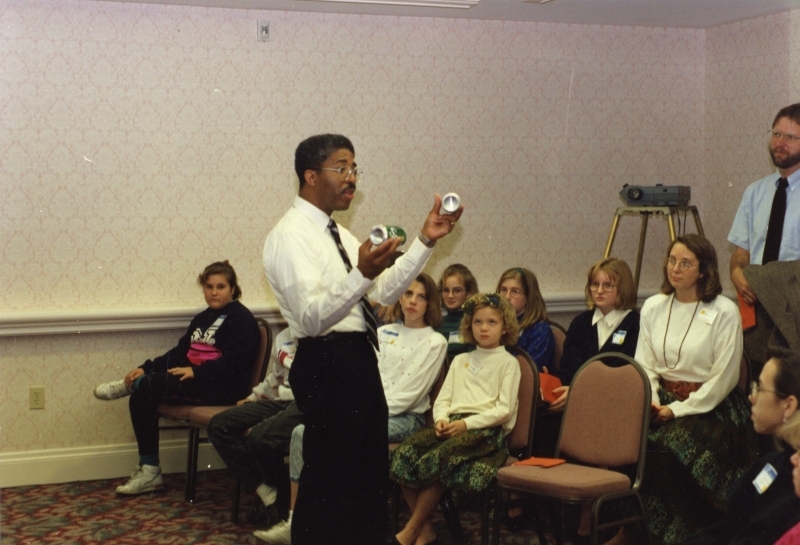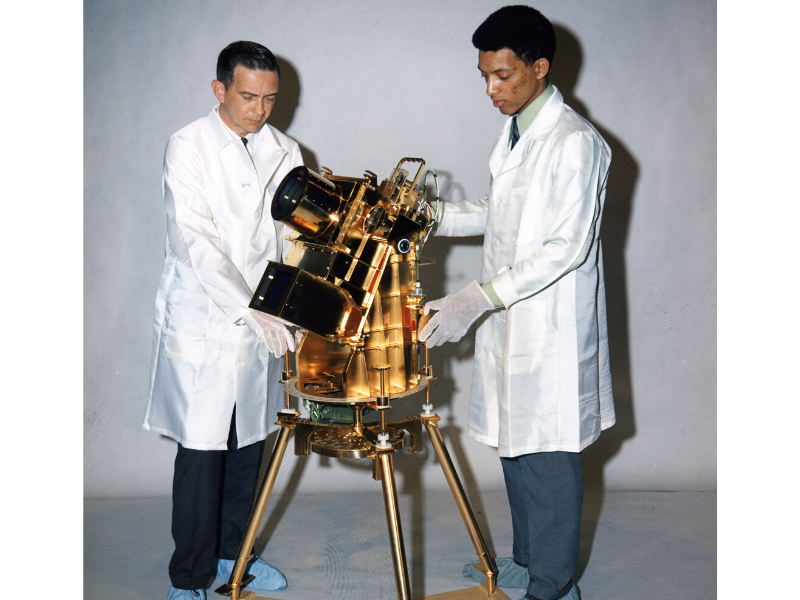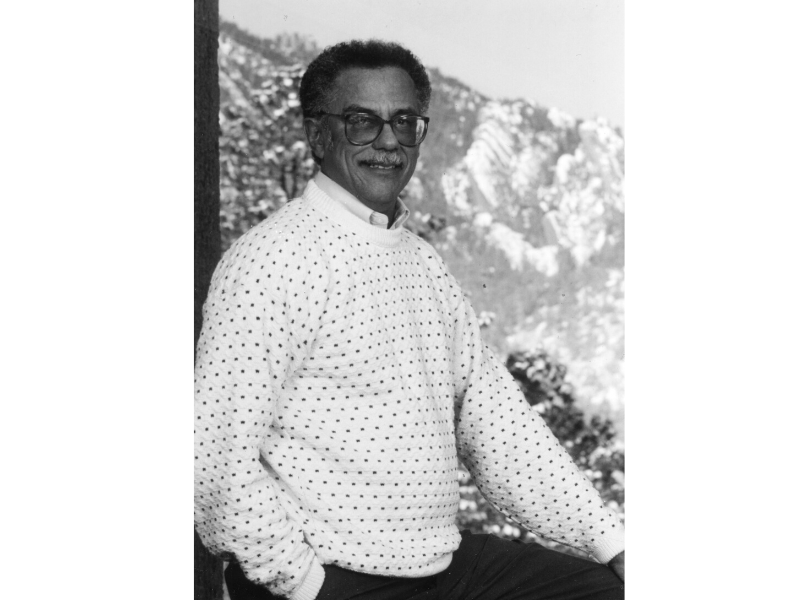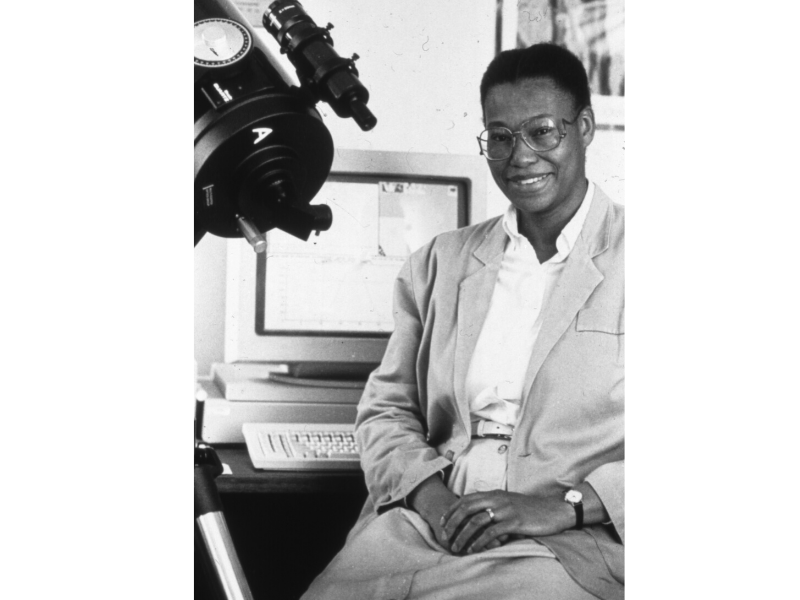
James Stith presents a lesson. Credit: AIP Emilio Segrè Visual Archives
Apart from the Emilio Segrè Visual Archives, our oral history collection, in which physicists tell the stories of their lives and careers, is one of our most-used collections. We currently only have four Black physicists in our oral history collection, and they are all men.* The reason for this is two-fold: 1) our collections reflect the current and historic under-representation of Black people in the physical sciences and more importantly 2) we have not consistently made concerted efforts as archivists, librarians, historians, and as the institution of the American Institution of Physics (AIP) to specifically include Black physicists in our collections. This is too large of an issue to cover in a Photos of the Month post, but it needs saying nonetheless. In the coming months, the Niels Bohr Library & Archives, the Center for History of Physics, and AIP are taking actions to make improvements as an organization, but this is only scratching the surface.
This being said, let us spend some time taking in some of the experiences faced by these four physicists from our oral histories and two Black woman physicists featured in the Emilio Segrè Visual Archives, keeping in mind that obstacles are only part of their story. Primary archival resources, like oral histories, allow us to read and hear about the experiences of Black scientists in their own words and from their own point of view, which is essential. I have attempted to keep my personal interpretation of the following quotes to an absolute minimum.
Photos of the Month is primarily a visual medium, but this month, it’s time to listen up and reflect.

James Stith presents a lesson. Credit: AIP Emilio Segrè Visual Archives
A man with too many accolades to list, James Stith (b. 1941) is a physics education researcher and former Vice President of the Physics Resources Center at the American Institute of Physics. He spent time in the military after he earned his doctorate in physics, and in his oral history interview, he talks about his experiences in the army as a Black man. He also discusses racially-motivated issues he noticed as a physics professor at West Point. He began to subtly advocate for Black students, and in his oral history he recounts conversations he had during bowling team practice with the other teachers:
I just put their names in the file, these are African-American cadets, these are white cadets — same basic SAT scores. Then I wrote a small computer program that would every now and then go into a database and pull up the grades of the white cadets and the African-American cadets. What I noticed was even for those kids who had very, very similar board scores, in terms of their grades, you would see something like this…
They were uneven, for the sake of the tape. You’re holding your hands up like that.
They were uneven, and they were about a file or two below the averages for the white cadet. I was an avid bowler back in those days. I bowled a couple of times a week. We had departmental bowling teams. What I started doing, while I’m sitting in the bowling alley talking to faculty — Let’s go back and take a look at the West Point education. During their freshman year, they took a double dose of mathematics and they took chemistry. That was the bulk of their courses they took. They took English and other things. When I bowled with the chemistry bowling team or we were bowling with the mathematics bowling team. We were sitting there and I would say, “You’ve got John Jones in your class?” “Yes I do.” “How is John doing?” “John’s doing well. John has a solid C.” “I would say I find it strange that with an SAT Math of 730 that John can only do C work in mathematics.” Invariably, the next time I would pull up the [academic] file, John had moved up and now there was no significant difference between the white kids and John Jones. And so I said, “Hmm, that’s interesting.” So I would then look at other kids and simply just sitting there having a conversation, I would simply ask the question. I mean I knew who the instructor was because I could look it up, and say something to that instructor. Invariably, the next time we look, they were here. [At the same level as comparable white cadets]

Shirley Jackson, Credit: Copyright Brooks/Glogau Studio, courtesy AIP Emilio Segrè Visual Archives
Physicist Shirley Ann Jackson (b. 1946) is the first Black woman to receive a doctorate from MIT in any field. Highlights from her amazing career include being the president of Rennselaer Polytechnic Institute for over twenty years and appointments by two U.S. presidents as an advisor in different positions. We do not currently have an oral history with her, but she describes an experience at MIT in this MIT Technology Review Article by Amanda Schaffer:
"Shirley Ann Jackson arrived at MIT in the fall of 1964 as one of just a handful of black students and the valedictorian of her public high school in Washington, D.C. In the midst of working on her first physics problem set, she emerged from her room and noticed all the other first-year women on her floor out in a common area, doing theirs together. “If you know anything about MIT, you know that working the problem sets is a big deal,” she says. “So I gathered up my paperwork and said, ‘May I join you?’
“One of them looked up and said, ‘Go away.’
“I said, ‘I’ve done half the problems already and I know how to do the other ones.’
“And another girl said, ‘Didn’t you hear her? She said go away.’”
And that was just the start. “It was pretty isolating,” Jackson says of her undergraduate years. Students avoided sitting next to her in lecture halls. If she joined others in the dining room, they would generally finish faster or skip their dessert. When that freshman study group rejected her, she went back to her room and cried. But after a while she told herself, “Well, I do have to hand in these physics problems.” So, she says, “I got myself together and finished the work.”"

Project Engineer William Conway (left) and Principal Investigator Dr. George Carruthers (right) with the Apollo 16 Far Ultraviolet Camera/Spectrograph instrument.
Credit: Naval Research Laboratory (NRL), courtesy AIP Emilio Segrè Visual Archives, Ronald E. Mickens Collection
George Carruthers (b. 1939) is the physicist who invented the ultraviolet camera/spectrograph that NASA used on the Apollo 16 mission. His accolades include the 2012 National Medal of Technology and Innovation awarded by president Barack Obama. He has also been active in developing opportunities for high school students and teachers, including creating the Science & Engineers Apprentice Program for high school student scientists. He talks about his high school to college transition in his oral history interview:
When I was in high school, at least certainly in the science area, I did very well. When I went to college, it came as quite a shock, because first of all, the level of competition was much higher and also because the professors were very impersonal in comparison to what it was like in high school, because I went to a mostly black high school and suddenly went to a mostly white university in which I was competing not with inner city kids like myself, but guys from the suburbs. I remember that because my mathematics background in high school was not adequate, not because I got bad grades, but because they just didn't have the courses that were required. I had to go to summer school the first year that I was in college and make up mathematics courses. I wasn't very good in mathematics, at least my first year in college, and I remember calculus being a very difficult course, and even physics was not all that easy when I took it in summer school, because they required calculus to be used in physics. That was quite a difference from what I was used to in high school.

Warren Washington, Credit: American Geophysical Union (AGU), courtesy of AIP Emilio Segrè Visual Archives
Warren Washington (b. 1936) has served as science advisor to former Presidents Carter, Reagan, Bush, Jr, and Clinton, and is an internationally recognized expert in the fields of climate research and atmospheric science. He currently works as a senior scientist at the National Center for Atmospheric Research. In his oral history, he talks about growing up in Portland:
In Portland I was called the typical epithets, and my father bought a home in a part of Portland where there weren’t very many Black families. I remember my mother telling me after I was grown that my father had to sit out on the front porch with a gun and so that people wouldn’t try to force us to move. He wanted to establish his presence in the neighborhood, when we first moved in. I think, though, that I basically grew up in a mixed neighborhood; as years went on, more and more Afro-Americans moved into the neighborhood. But I never considered racial issues to be an overwhelming problem. I think I got enough support at home emotionally as well as from friends. In fact, what was interesting is that the middle class Afro-Americans — probably not that unusual for places like Seattle and Portland or San Francisco or L.A. in those years — were all kind of working-class families. It seemed in that generation all kids were expected to go to college. Not to say all, but many were expected to go to college. One of the disappointments for me was a pattern seen in many good high schools…and Jefferson was a very good high school, in that students do not take advantage of education opportunities. As I took my physics, math, and chemistry courses, there were other minority students who did reasonably well in their coursework, didn’t feel confident enough to go on to college. And that was a disappointment to me, because if I was able to succeed, I’m sure that they could have. And they avoided going off to a place like Oregon State. Oregon State at that time (as I said in my earlier interviews) couldn’t have had more than eight or ten Black students or minorities. Most of them were on the football team. There was only one Black family living in Corvallis at the time.
Wow! Was that uncomfortable?
No. As I said, I grew up in kind of a mixed neighborhood, so I had white friends and Black friends and so forth. I think I learned how to cope in that world. I think the programs which are like the NSF supported programs to attract underrepresented students, which we have here at NCAR in order to bring minority kids in the atmospheric sciences, can be successful — I think one of the things is that minority students need to sometimes learn how to live in a multicultural world, a world that isn’t all Afro-American or Hispanic or whatever. I think they need that kind experience. I’m not saying it’s bad to go to an all-Black college or mostly Hispanic college; I think you just need to learn how to deal with the real world.

Sekazi Mtingwa, Credit: Argonne National Laboratory, courtesy of AIP Emilio Segrè Visual Archives, Physics Today Collection
Sekazi Mtingwa (b. 1949) co-founded the National Society of Black Physicists in 1977, founded the African Laser Centre and co-founded the Triangle Science, Education & Economic Development in 2011. He is a Fellow of the American Physical Society, he teaches at several universities, and has made significant contributions and discoveries in the field of theoretical high-energy physics throughout his research career. From his oral history interview:
So, you said that your entire schooling before college was at all-black schools, or were you integrated at any point?
Yes, all-black schools in Atlanta. Segregated. You know, as a young person growing up in a segregated system, you didn’t think about it so much. It was only when you got older and realized that even though you had great teachers, your facilities were not as good as those at white schools. For instance, I remember — I guess it was around my senior year, our school built a new gymnasium. And I was so impressed by it. But then, I had the opportunity to be on one of these Georgia state all-star bands. I played baritone in the band, and I went to that. The practice we had was in one of the white schools, and there was just no comparison between their new gym [laughs] and our new gym. I said: hey, wait a minute! What’s going on here? [laughs] But only when I left school, or my last days in school, that I realized what segregation was all about.

Mercedes Richards, Credit: Astronomical Society of the Pacific, courtesy of AIP Emilio Segrè Visual Archives, Physics Today Collection
Mercedes Richards (1955-2016) was a Jamaican-born astronomer and Penn State professor. She was awarded the Musgrave Gold Medal, Jamaica’s highest academic honor, for her achievements in astronomy. We do not have an oral history with her, but here is a story from her Penn State profile in which Adam Eshleman interviewed Mercedes Richards:
"The high school that Richards attended in Kingston, St. Hugh's, was segregated by gender; her classmates, as well as her teachers, were all female. "Having those female teachers gave me a boost," she recalls. "As a young woman I could say, "Hey, I can be like them." Thus inspired, she was able to soldier on through graduate school at the University of Toronto at a time when she says an all-male faculty tended to be tough on female students. The early encouragement also helped in her first academic position in a department where she was the only female faculty member."
Lastly, some words from Mercedes Richards about astronomy from this profile:
"'What I do is definitely detective work,'" she explains. 'Astronomers want to know what happened. We look for evidence. We have to piece it all together like forensic scientists of the sky.'"
* Note: At the time of writing, we have not published any oral history interviews with Black woman scientists, but there are interviews with Black woman scientists that have taken place and are being processed, as well as additional interviews in the planning stages.
The AIP National Task Force to Elevate African American Representation in Undergraduate Physics & Astronomy (TEAM-UP). (2020). The Time is Now: Systemic Changes to Increase African Americans with Bachelor’s Degrees in Physics and Astronomy. American Institute of Physics. https://www.aip.org/sites/default/files/aipcorp/files/teamup-full-repor…
Eshleman, Adam. (2009, August 05). Stellar Detective: A profile of professor Mercedes Richards. Penn State University. https://news.psu.edu/story/141653/2009/08/05/research/stellar-detective…
Gottlieb, Jane. (2019). A Celebration of Leadership. Rennselaer Alumni Magazine. Retrieved June 29, 2020, from https://magazine.rpi.edu/feature/a-celebration-of-leadership
Interview of George Carruthers by David DeVorkin on 1992 August 18, Niels Bohr Library & Archives, American Institute of Physics, College Park, MD USA, www.aip.org/history-programs/niels-bohr-library/oral-histories/32485
Interview of James Stith by Will Thomas on 2009 August 14, Niels Bohr Library & Archives, American Institute of Physics, College Park, MD USA, www.aip.org/history-programs/niels-bohr-library/oral-histories/33903
Interview of Sekazi Mtingwa by David Zierler on March 27, 2020, Niels Bohr Library & Archives, American Institute of Physics, College Park, MD USA, www.aip.org/history-programs/niels-bohr-library/oral-histories/XXXX
Interview of Warren Washington by Paul Edwards on 1998 October 28 and 29, Niels Bohr Library & Archives, American Institute of Physics, College Park, MD USA, www.aip.org/history-programs/niels-bohr-library/oral-histories/33098
Schaffer, Amanda. (2017) The Remarkable Career of Shirley Ann Jackson. MIT Technology Review. Retrieved June 29, 2020 from https://www.technologyreview.com/2017/12/19/146775/the-remarkable-caree…
Warren Washington. (2020). National Center for Atmospheric Research. Retrieved June 29, 2020, from https://staff.ucar.edu/users/wmw
#BlackInAstro: Black Women in Astronomy and Physics: Kate Storey-Fisher
A Break-Up Letter with Astronomy, From a Young Black Woman: Lauren Chambers
A fascinating bit of Fermilab's History: Ariel Waldman
Public Thinker: Chanda Prescod-Weinstein on Dark Matter and White Empiricism: Lawrence Ware
Add new comment